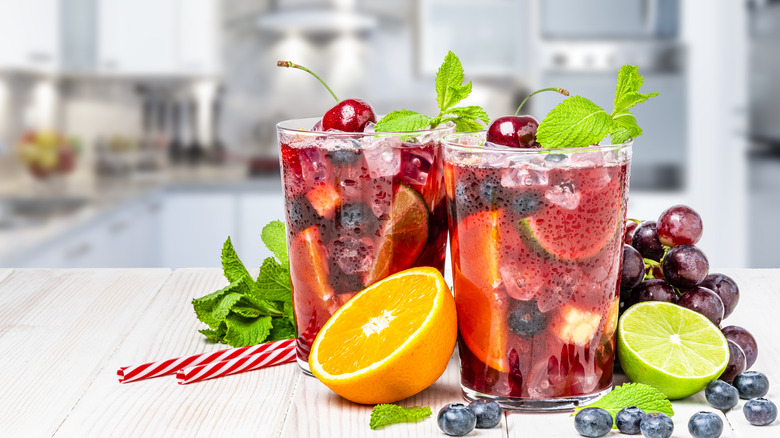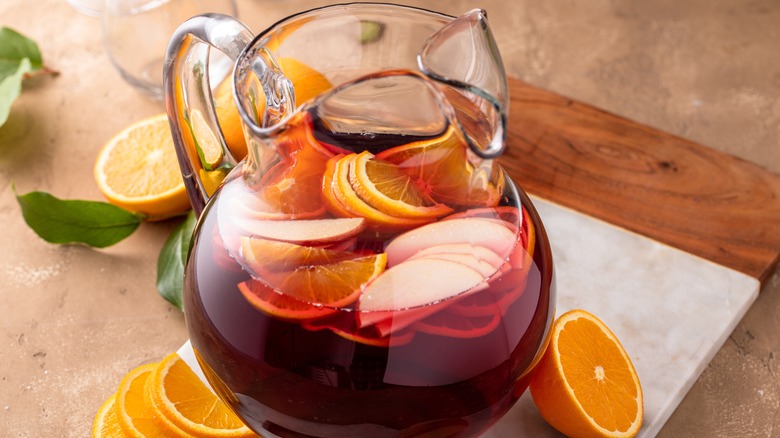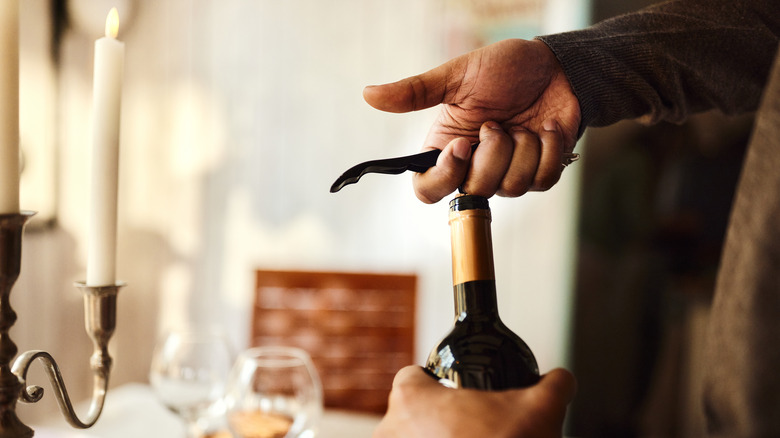Restaurants Use Leftover Wine To Make Sangria And So Should You
Leftovers are great, especially when they can be used to create a new dish. Succulent Indian butter chicken was invented to provide a use for leftover grilled tandoori chicken. And you can't really make decent fried rice (let alone the best fried rice) without using leftover cooked rice that has had a chance to dry out in the fridge. By the same token, there's a use for leftover wine that's been open long enough to become a bit flat and stale: sangria! Restaurants to this, and so should you. Remember that leftover wine (that was drinkable when opened) may not have actually gone bad: It could be perfectly safe to consume, just oxidized to the extent that it won't be as lively as it was when you opened it. Say it with us: Leftover wine? Sangria time.
It's absolutely possible for wine to go bad — but you would know this the moment the cork comes out of the bottle. This is known as corked wine, which is caused by cork mold. Corked wines, or contaminated wines, are not detectable before they're opened and are not hard to miss once they are: They smell damp and moldy and taste like wet cardboard. Wines get corked before they're even open — so if your first glass tastes good, the leftovers can be poured into a pitcher of sangria.
Sangria is simple to make
Any sangria recipe — and boy there are lots — includes not only wine but other adjuncts like fresh fruit, soda water, sundry other spirits, and aromatic herbs. In other words, it's a bright, fruity cocktail punch that doesn't rely solely on the vitality of a freshly opened bottle of wine. While mixologists tend to believe that the alcoholic punch made from wine, sugar, and citrus called sangria was invented in 1961, there was an 18th-century drink called sangaree that likely contained wine, water, sugar, nutmeg, and a little Javanese rum.
Since then, sangria has evolved into a peculiarly refreshing spring and summer concoction that can contain red, white, or rosé wine, all manner of fruit from limes to oranges to pomegranates, spirituous additives like sake or brandy, fresh fragrant mint or basil leaves, and simple syrup. In other words, literally whatever leftover wine of any color you're thinking about pouring down the sink should be poured instead into a big ol' pitcher of sangria.
You've got options
Use the type of wine you have left over to design your sangria. Is it a big Rioja? Go old school and make a red sangria with brandy. Maybe it's a grassy white, like Sauvignon Blanc — mix it up with fresh lemons, strawberries, and an elderflower liqueur to make a luscious sangria flora. Rosé wines pair really well with fresh fruit like raspberries and blueberries, and even dried ones like currants. To avoid overwhelming a rosé sangria by adding something as big as brandy, consider a lightly bitter, herbal apéritif like Campari.
This exercise will help develop your wine palate because the fruity and herbal notes inherent in the bottle will help you select your other sangria ingredients. For example, many German rieslings have notes of stone fruit such as peaches, while some California chardonnays suggest tropical fruit or Meyer lemon. A rosé from Provençal would love a little nectarine and melon. Simply extend those profiles with the right fruit. Beyond that, your sangria should have a good balance of body, booze, acidity, and sweetness. The great news is if you add too much of one thing like lemon juice, another dash of triple sec should sort that right out.


